Eeem Eim a Wide Continuous Area of Something 2017
- Weekly Report
- Archive
- Feeds
- Criteria & Disclaimers
- Acronyms & Abbreviations
All times are local unless otherwise stated.
Alaid | 5 October-11 October 2022 | New Activity / Unrest | |
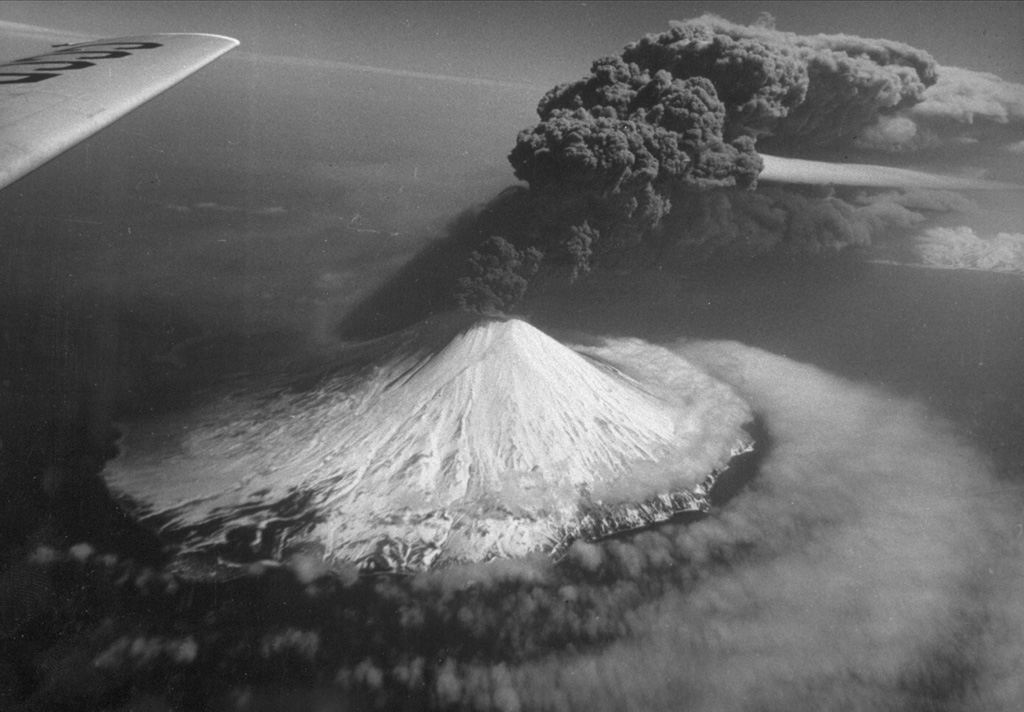 Alaid AlaidKuril Islands (Russia) | KVERT reported that a new lava flow descended Alaid's S flank during 27-28 September and continued to be active at least through 6 October; a thermal anomaly was identified in satellite images throughout that same period of time. The Aviation Color Code remained at Orange (the second highest level on a four-color scale). Dates are based on UTC times; specific events are in local time where noted. Source: Kamchatkan Volcanic Eruption Response Team (KVERT) |
Chirinkotan | 5 October-11 October 2022 | New Activity / Unrest | |
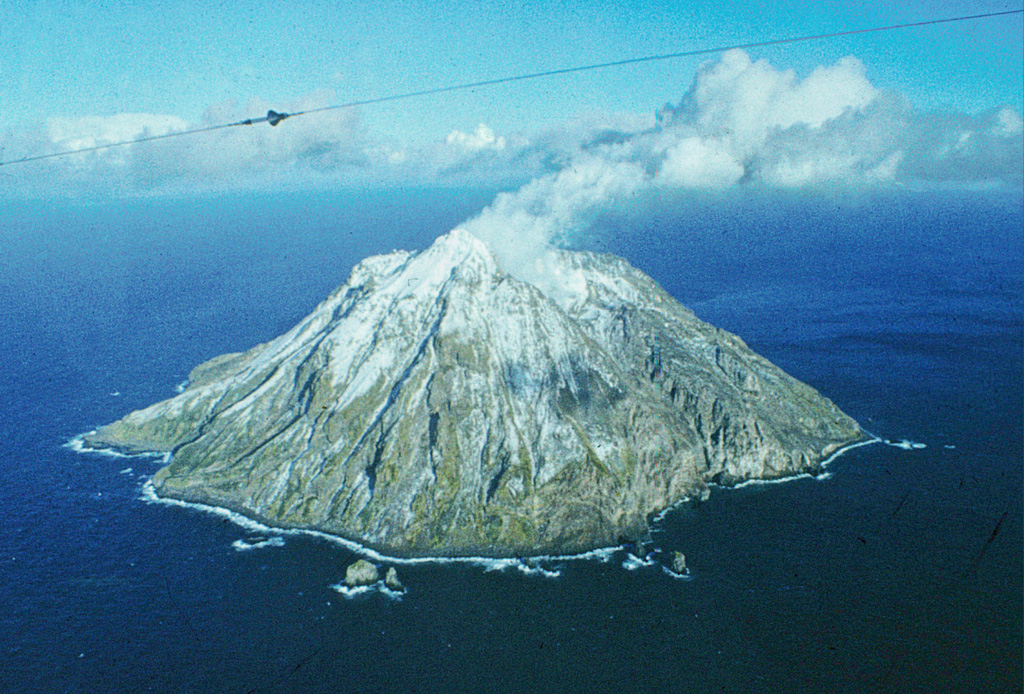 Chirinkotan ChirinkotanKuril Islands (Russia) | SVERT reported that an ash plume from Chirinkotan was identified in satellite images at 1030 on 7 October rising 3.5-4 km (11,500-13,100 ft) a.s.l. and drifting 80 km ESE. The Aviation Color Code was raised to Yellow (the second lowest level on a four-color scale). Source: Sakhalin Volcanic Eruption Response Team (SVERT) |
Grimsvotn | 5 October-11 October 2022 | New Activity / Unrest | |
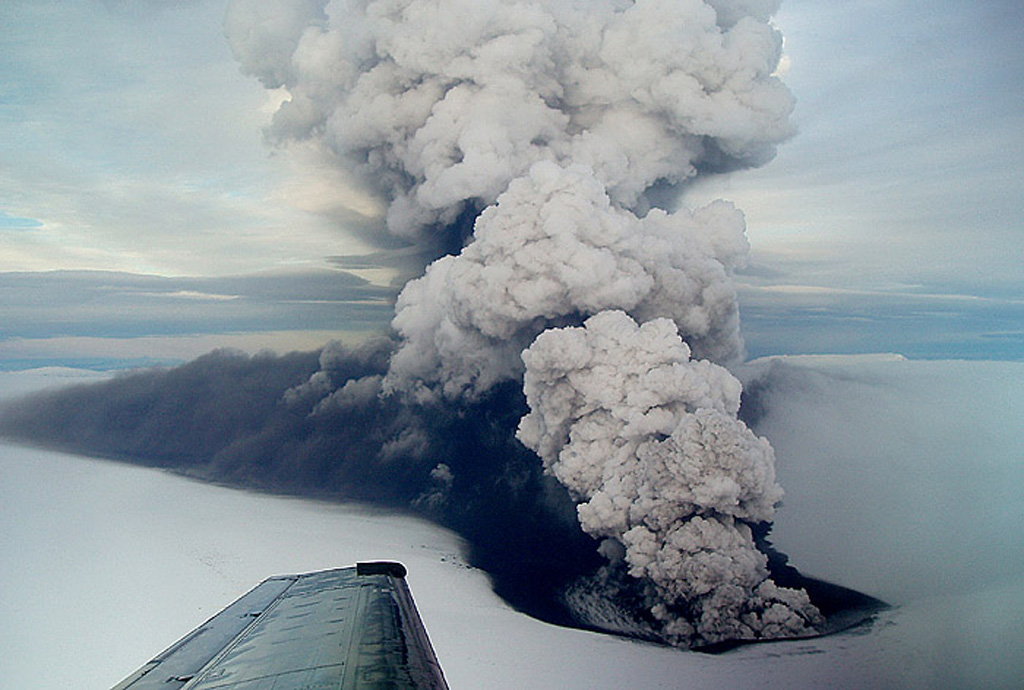 Grimsvotn GrimsvotnIceland | Icelandic Meteorological Office (IMO) reported that recent GPS measurements indicated that the ice sheet had subsided about 3 m and the lake beneath the glacier at Grímsvötn had begun to drain, though the water had not reached the glacier's margins. IMO forecasted a small jökulhlaup and raised the Aviation Color Code to Yellow (the second lowest level on a four-color scale) on 10 October. The report noted that neither seismicity nor gas emissions were elevated, though activity at the volcano had been increasing over time. Notably, a pulse of seismic tremor was recorded for about an hour during the previous week, and magmatic gases were measured in fumarolic plumes in 2020. By 12 October the outflow of water was about 300 cubic meters per second, with the onset of the jökulhlaup occurring slower than initially calculated, and the ice sheet had subsided a total of 7 m. The flooding was likely going to be equal to that seen during the summer and would likely not impact bridges or structures. Source: Icelandic Meteorological Office (IMO) |
Mauna Loa | 5 October-11 October 2022 | New Activity / Unrest | |
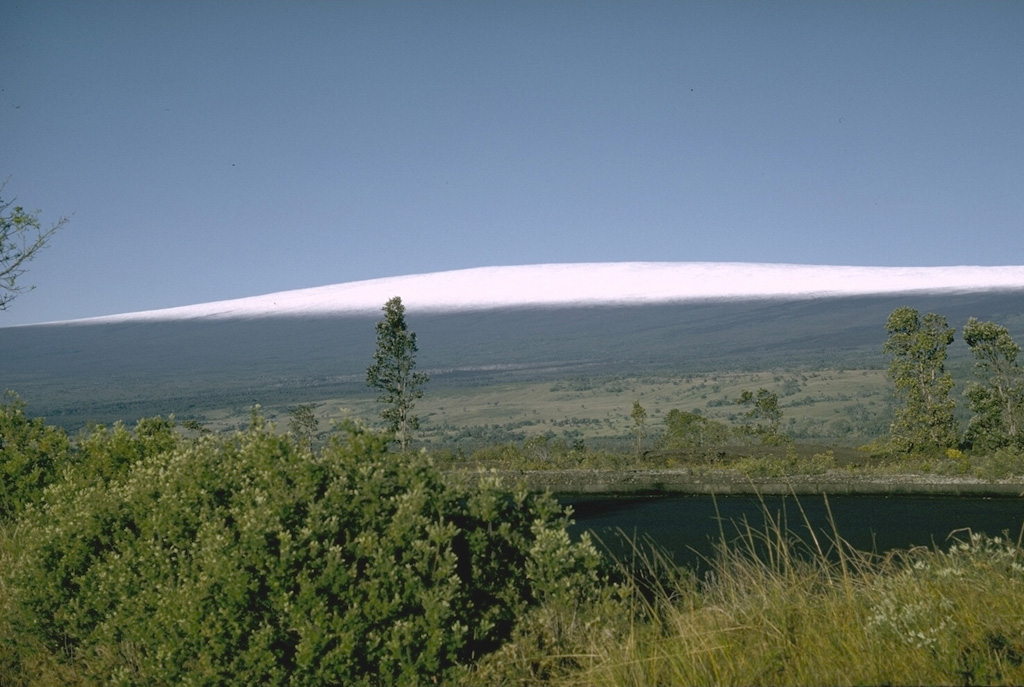 Mauna Loa Mauna LoaHawaiian Islands (USA) | On 5 October HVO noted recent increases in seismicity and deformation at Mauna Loa. The number of earthquakes increased from 5-10 per day in June to 10-20 per day during July-August. The number of daily earthquakes again intensified, to 40-50 per day, starting at about 0200 on 23 September, and peaks as high as 100 per day were recorded on 23 and 29 September. The small-magnitude (less than M3) earthquakes occurred beneath Moku'aweoweo, the summit caldera, at depths of 2-3 km. Inflation accompanied the swarm and had also increased during the past two weeks. Daily earthquake counts were relatively unchanged during 6-12 October. Data from Global Positioning System (GPS) instruments at the summit and flanks showed continuing inflation, though data from tiltmeters at the summit did not show significant surface deformation over the past week. Earthquakes were clustered beneath the summit caldera at depths of 3-5 km and below the NW flank at depths of 6-8 km. The Volcano Alert Level remained at Advisory (the second lowest level on a four-level scale) and the Aviation Color Code remained at Yellow (the second lowest level on a four-color scale). Source: US Geological Survey Hawaiian Volcano Observatory (HVO) |
Mayon | 5 October-11 October 2022 | New Activity / Unrest | |
 Mayon MayonLuzon (Philippines) | PHIVOLCS reported that since the Alert Level for Mayon was raised to 1 (on a 0-5 scale) on 21 August monitoring data had showed nothing notable. Changes in morphology of the dome and minor aseismic extrusion estimated at about 40,000 cubic meters was detected during 6 June-20 August based on daily visual and camera monitoring data. Based on these observations, the lava dome grew an additional 48,000 cubic meters by 4 October; re-mobilized light-colored ash had been deposited in Miisi Gully (S flank) beginning 2 October, likely derived from lava fragmentation during the extrusion process. Freshly extruded lava at the base of the summit lava dome was seen during an aerial survey conducted on 7 October. PHIVOLCS raised the Alert Level to 2 that same day. Daily white steam plumes were visible drifting down-flank and then to the W, WSW, and SSW during 8-10 October. Electronic Distance Measuring (EDM), precise leveling, continuous GPS, and electronic tilt monitoring data showed that the volcano had been slightly inflated, especially on the NW and SE flanks, since 2020. Short-term inflation on the W to SW flanks and short-term deflation on the E and SE flanks had been detected since August. Source: Philippine Institute of Volcanology and Seismology (PHIVOLCS) |
Nishinoshima | 5 October-11 October 2022 | New Activity / Unrest | |
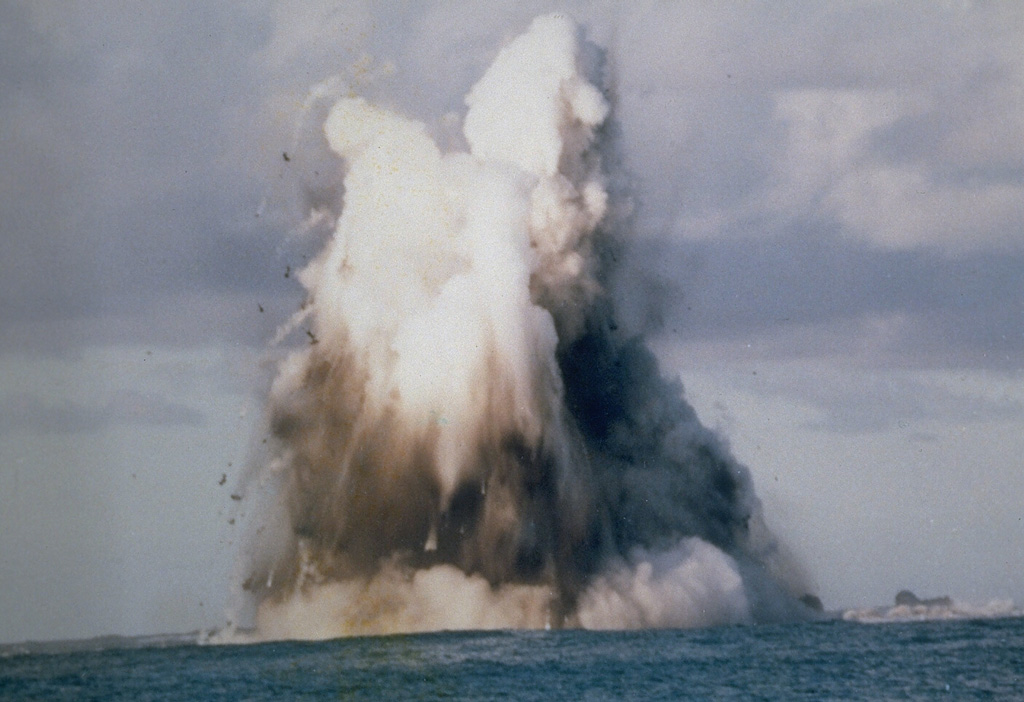 Nishinoshima NishinoshimaIzu Islands | JMA reported that the eruption at Nishinoshima continued during 5-11 October. Ash plumes rose 2.2-3.5 km (7,200-11,500 ft) a.s.l. and drifted in multiple directions. Sources: Japan Meteorological Agency (JMA), Tokyo Volcanic Ash Advisory Center (VAAC) |
Stromboli | 5 October-11 October 2022 | New Activity / Unrest | |
 Stromboli StromboliAeolian Islands (Italy) | INGV reported that activity at Stromboli had been more intense in the past two weeks with a large explosion on 29 September, short-lived lava overflows of the craters during 3-4 October, and collapses with pyroclastic flows and lava flows on 9 October. At 1524 on 29 September an explosion at vent N2 in Area N (North Crater area) generated an ash plume that rose 300 m above the summit and ejected abundant lava fragments, lapilli, and bombs along the Sciara del Fuoco. Activity during 3-9 October generally consisted of ongoing explosions from three vents in Area N and at least two vents in Area C-S (South-Central Crater area). Low-intensity explosions from the N1 vent (Area N) ejected bombs and lapilli 80-150 m high every 10-20 minutes. Explosions ejecting coarse material, along with sometimes intense spattering, occurred at two N2 vents. Explosions from at least two vents in Area C-S, which were not visible due to the camera views, ejected ash and coarse material less than 150 m above the vent at a rate of 1-6 events per hour. At 1108 on 3 October a fissure opened on the outer flank of N2, within the Sciara del Fuoco, and produced a lava flow that traveled to the coast; the flow was cooling by 1800. At 1107 the next morning, 4 October, lava overflowed the N crater (likely N2) and unconsolidated lava rolled down the upper part of the Sciara del Fuoco. Activity again intensified on 9 October beginning at 0921 when lava overflowed from an area in the N part of N2 and lava effused from the fissure that had opened on 3 October. At 0922 the rim of N2 collapsed and generated a pyroclastic flow that traveled down the Sciara del Fuoco, reached the sea within 30 seconds, and advanced over the water for a few hundred meters. Immediately afterwards a large amount of lava flowed down the Sciara del Fuoco in two main branches and reached the coast within a few minutes. Lava continued to flow to the coast during the rest of the day. The Dipartimento della Protezione Civile raised the Alert Level to Orange (the second highest level on a four-color scale). Collapses of material in the Sciara del Fuoco continued overnight, possibly due to erosion of the channels from lava flows. By 0919 on 10 October lava flows were only reaching part way down the Sciara del Fuoco, stopping about 400 m from the coast. Lava flows continued to stop part way down the flank during 10-12 October. Frequent collapses of material in the channel eroded by the lava flow and material from the lava flow itself descended to the coast. Spattering from Area N was visible. Sources: Dipartimento della Protezione Civile, Sezione di Catania - Osservatorio Etneo (INGV) |
Taal | 5 October-11 October 2022 | New Activity / Unrest | |
 Taal TaalLuzon (Philippines) | PHIVOLCS reported continuing unrest at Taal during 5-11 October. Upwelling gasses and hot fluids in the lake continued to be visible. A small, three-minute-long phreatomagmatic burst occurred on 5 October; according to the Washington VAAC an ash plume rose to 600 m (2,000 ft) a.s.l. and drifted SW. White steam emissions rose 900 m above the lake, though during 10-11 October plumes rose as high as 2.4 km. The Alert Level remained at 1 (on a scale of 0-5), and PHIVOLCS reminded the public that the entire Taal Volcano Island was a Permanent Danger Zone (PDZ). Source: Philippine Institute of Volcanology and Seismology (PHIVOLCS) |
Aira | 5 October-11 October 2022 | Continuing Activity | |
 Aira AiraKyushu (Japan) | JMA reported that nine eruptive events and one explosion at Minamidake Crater (at Aira Caldera's Sakurajima volcano) were recorded during 3-10 October. Volcanic plumes rose as high as 1.5 km above the crater rim and large blocks were ejected 600-900 m from the vent. Incandescence at the crater was visible nightly. The Alert Level remained at 3 (on a 5-level scale), and residents were warned to stay 2 km away from the crater. Source: Japan Meteorological Agency (JMA) |
Bulusan | 5 October-11 October 2022 | Continuing Activity | |
 Bulusan BulusanLuzon (Philippines) | PHIVOLCS issued a special advisory for Bulusan on 7 October, noting that 29 volcanic earthquakes were recorded from 0500 on 6 October until the time the report was issued at 1500 on 7 October. Minor white steam emissions rose from vents in the crater and from NW vents. Data from continuous GPS and radial tilt measurements indicated short-term inflation on the S flanks since April 2022. The inflation and increased seismicity were likely caused by shallow hydrothermal processes. The Alert Level remained at 0 (on a scale of 0-5) and PHIVOLCS reminded the public not to enter the 4-km-radius Permanent Danger Zone (PDZ) nor the 2 km Extended Danger Zone (EDZ) on the SE flank. Source: Philippine Institute of Volcanology and Seismology (PHIVOLCS) |
Ebeko | 5 October-11 October 2022 | Continuing Activity | |
 Ebeko EbekoParamushir Island (Russia) | KVERT reported that moderate activity at Ebeko was ongoing. According to volcanologists in Severo-Kurilsk (Paramushir Island, about 7 km E) explosions generated ash plumes that rose to 3.5 km (11,500 ft) a.s.l. and drifted E and NE during 29 September-6 October. Ashfall was reported in Severo-Kurilsk on 29 September and 6 October. The Aviation Color Code remained at Orange (the second highest level on a four-color scale). Dates are based on UTC times; specific events are in local time where noted. Source: Kamchatkan Volcanic Eruption Response Team (KVERT) |
Fuego | 5 October-11 October 2022 | Continuing Activity | |
 Fuego FuegoSouth-Central Guatemala | INSIVUMEH reported that 5-10 explosions per hour were recorded at Fuego during 4-10 October, generating ash plumes that rose as high as 1.2 km above the crater rim. The ash plumes drifted as far as 20 km NW, W, SW, and SSW causing almost daily ashfall in areas downwind including Morelia (9 km SW), Panimaché I and II (8 km SW), Santa Sofía (12 km SW), El Porvenir (8 km ENE), Los Yucales (12 km SW), Sangre de Cristo (8 km WSW), El Porvenir (8 km ENE), San Pedro Yepocapa (8 km NW), Finca Palo Verde, La Rochela, and Ceilán. Daily shock waves rattled structures in communities around the volcano. Daily block avalanches descended the Ceniza (SSW), Seca (W), Trinidad (S), Taniluyá (SW), Honda, Las Lajas (SE), and El Jute (ESE) drainages, often reaching vegetated areas. Explosions ejected incandescent material as high as 350 m above the summit on some of the days. Lahars resulting from substantial rainfall descended the Las Lajas and El Jute drainages on the ESE flank on 11 October, carrying tree branches, trunks, and blocks as large as 1.5 m in diameter. Source: Instituto Nacional de Sismologia, Vulcanologia, Meteorologia, e Hidrologia (INSIVUMEH) |
Great Sitkin | 5 October-11 October 2022 | Continuing Activity | |
 Great Sitkin Great SitkinAndreanof Islands (USA) | AVO reported that continuing slow lava effusion at Great Sitkin was confirmed by a 5 October satellite image and likely continued during 6-11 October. Seismicity remained at low levels, though it slightly increased during 5-6 October. Elevated surface temperatures were identified during 4-8 October; weather clouds prevented webcam and satellite views during 8-11 October. The Volcano Alert Level remained at Watch (the second highest level on a four-level scale) and the Aviation Color Code remained at Orange (the second highest level on a four-color scale). Source: US Geological Survey Alaska Volcano Observatory (AVO) |
Home Reef | 5 October-11 October 2022 | Continuing Activity | |
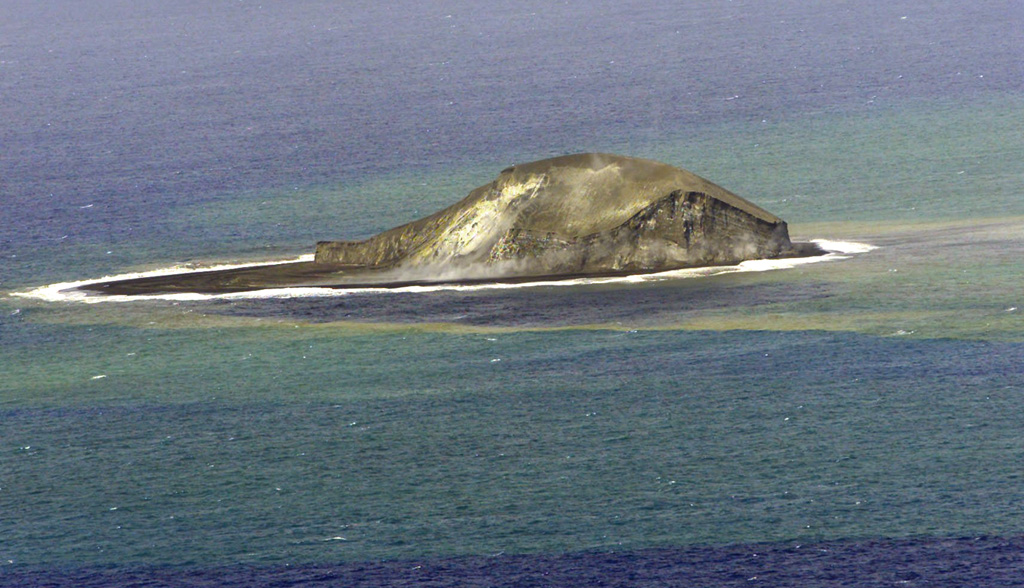 Home Reef Home ReefTonga Ridge | The Tonga Geological Services reported that daily steam plumes from Home Reef were identified in satellite images during 4-11 October. The Aviation Color Code was raised to Orange (the second highest level on a four-color scale) on 5 October. At 0040 on 6 October an ash plume rose as high as 3 km (10,000 ft) a.s.l. and drifted 5 km SE. Satellite-based measurements showed that the island had not changed in size between 28 September and 10 October, remaining at 268 m N-S and 283 m E-W. The island reached 15-18 m above the water surface, and was steeper on the E half but more gently sloped on the W. The daily emission count variable with about 8-19 events per day during 4-9 October and about 1-3 per day during 10-11 October. The Aviation Color Code was lowered to Yellow on 11 October. Mariners were advised to stay 4 km away from the volcano. Source: Tonga Geological Services, Government of Tonga |
Ibu | 5 October-11 October 2022 | Continuing Activity | |
 Ibu IbuHalmahera | PVMBG reported that the eruption at Ibu continued during 4-11 October. Daily gray-and-white ash plumes of variable densities rose as high as 1 km above the summit and drifted in multiple directions. The Alert Level remained at a 2 (on a scale of 1-4), and the public was warned to stay at least 2 km away from the active crater and 3.5 km away on the N side. Source: Pusat Vulkanologi dan Mitigasi Bencana Geologi (PVMBG, also known as CVGHM) |
Karymsky | 5 October-11 October 2022 | Continuing Activity | |
 Karymsky KarymskyEastern Kamchatka (Russia) | KVERT reported that a thermal anomaly over Karymsky was identified in satellite images on 30 September and during 1-2 and 5-6 October. The Aviation Color Code remained at Orange (the second highest level on a four-color scale). Dates are based on UTC times; specific events are in local time where noted. Source: Kamchatkan Volcanic Eruption Response Team (KVERT) |
Katmai | 5 October-11 October 2022 | Continuing Activity | |
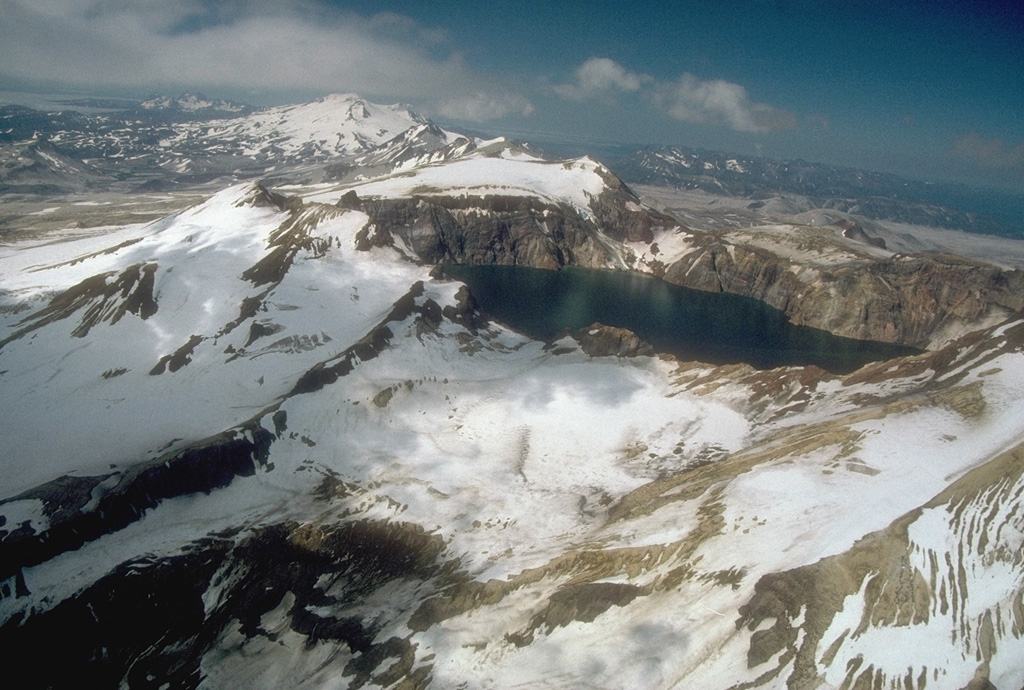 Katmai KatmaiAlaska | AVO reported that on 9 October strong winds in the vicinity of Katmai and the Valley of Ten Thousand Smokes blew unconsolidated ash SE across Shelikof Strait to Kodiak Island at an altitude up to 1.5 km (5,000 ft) a.s.l. The ash was originally deposited during the Novarupta eruption in 1912. The Volcano Alert Level remained at Normal (the lowest level on a four-level scale) and the Aviation Color Code remained at Green (the lowest level on a four-color scale). Source: US Geological Survey Alaska Volcano Observatory (AVO) |
Kilauea | 5 October-11 October 2022 | Continuing Activity | |
 Kilauea KilaueaHawaiian Islands (USA) | HVO reported that by 5 October about 111 million cubic meters of lava had been erupted from the vent in the lower W wall of Kilauea's Halema`uma`u Crater since the current eruption began on 29 September 2021, raising the crater floor by 143 m. Lava continued to enter the lake during 5-11 October. The active part of the lake stayed at a relatively steady level through the week, varying only slightly. The Volcano Alert Level remained at Watch (the second highest level on a four-level scale) and the Aviation Color Code remained at Orange (the second highest level on a four-color scale). Source: US Geological Survey Hawaiian Volcano Observatory (HVO) |
Lewotolok | 5 October-11 October 2022 | Continuing Activity | |
 Lewotolok LewotolokLembata Island | PVMBG reported that the Strombolian eruption at Lewotolok continued during 5-11 October. Daily white emissions rose as high as 500 m above the summit and drifted W, NW, and NE. White-and-gray plumes rose as high 200 m and drifted NW and W during 9-10 October. Webcam images posted with the daily observatory reports often showed incandescence above the crater rim. The Alert Level remained at 3 (on a scale of 1-4) and the public was warned to stay 3 km away from the summit crater and 4 km away from the crater on the SE flank. Source: Pusat Vulkanologi dan Mitigasi Bencana Geologi (PVMBG, also known as CVGHM) |
Merapi | 5 October-11 October 2022 | Continuing Activity | |
 Merapi MerapiCentral Java | BPPTKG reported that the eruption at Merapi continued during 30 September-6 October and seismicity remained at high levels. The SW lava dome produced as many as five lava avalanches that traveled as far as 1.8 km down the Bebeng drainage on the SW flank, and one that traveled 800 m down the W flank upstream of upstream of Kali Putih. No significant morphological changes to the central and SW lava domes were evident in drone photographs, though both domes continued to grow. The Alert Level remained at 3 (on a scale of 1-4), and the public was warned to stay 3-7 km away from the summit based on location. Source: Balai Penyelidikan dan Pengembangan Teknologi Kebencanaan Geologi (BPPTKG) |
Nevados de Chillan | 5 October-11 October 2022 | Continuing Activity | |
 Nevados de Chillan Nevados de ChillanCentral Chile | SERNAGEOMIN reported continuing activity at Nevados de Chillán during 16 September-11 October. Dome 4 in Nicanor Crater grew until mid-September, coincident with thermal anomalies seen in satellite images, which decreased and were not present during the second half of the month. Explosions during 16-30 September and into early October produced ash plumes that generally rose no higher than 1 km above the crater rim. Notably, an explosion on 19 September produced an ash plume that rose 1.1 km and drifted SE, and ejected blocks 500 m from the crater rim. An incandescent ash plume from a second explosion rose 1.7 km and drifted SE, causing ashfall on that flank. The explosions that day partially destroyed the dome. At 1906 on 8 October a long-period earthquake signal was followed by an ash plume that rose 1.7 km and drifted NNE. An explosion at 1926 on October generated a dense ash plume that rose 2.5 km and drifted NNW. Pyroclastic flows traveled short distances down the NNW flank. The Alert Level remained at Yellow, the second lowest level on a four-color scale. Sistema Nacional de Prevención y Respuesta ante Desastres (SINAPRED) maintained an Alert Level Yellow (the middle level on a three-color scale) for the communities of Pinto and Coihueco, and reminded residents not to approach the crater within 2 km. Sources: Servicio Nacional de Geología y Minería (SERNAGEOMIN), Oficina Nacional de Emergencia-Ministerio del Interior (ONEMI) |
Pavlof | 5 October-11 October 2022 | Continuing Activity | |
 Pavlof PavlofAlaska Peninsula, Alaska | AVO reported that a minor eruption at a vent on Pavlof's upper E flank was ongoing during 4-11 October. Seismic tremor continued. Strongly elevated surface temperatures were identified in satellite images during 5-6 October and incandescence was visible in nighttime webcam images. Discolored snow near the vent was visible in webcam views during the morning of 7 October suggesting low-level explosive activity; a small explosion was recorded at 1503 that same day though cloudy conditions prevented visual confirmation. Two small explosions were detected during 8-11 October. Very small ash emissions and lava near the vent were visible in occasional clear webcam images during 10-11 October. The Volcano Alert Level remained at Watch (the second highest level on a four-level scale) and the Aviation Color Code remained at Orange (the second highest level on a four-color scale). Source: US Geological Survey Alaska Volcano Observatory (AVO) |
Rincon de la Vieja | 5 October-11 October 2022 | Continuing Activity | |
 Rincon de la Vieja Rincon de la ViejaCosta Rica | OVSICORI-UNA reported continuing eruptive activity at Rincón de la Vieja characterized by occasional small phreatic explosions. A small explosion at 1923 on 4 October lasted two minutes but was not visually observed due to darkness and weather conditions. Small gas-and-steam emissions were recorded at 1647 on 8 October and 0940 on 9 October; at least the first emission was seen rising above the crater rim. Source: Observatorio Vulcanologico y Sismologico de Costa Rica-Universidad Nacional (OVSICORI-UNA) |
Santa Maria | 5 October-11 October 2022 | Continuing Activity | |
 Santa Maria Santa MariaSouthwestern Guatemala | INSIVUMEH reported that the eruption at Santa María's Santiaguito lava-dome complex continued during 4-11 October. Effusion from Caliente cone fed lava flows that descended the San Isidro and El Tambor drainages on the W and SW flanks. Block avalanches from the dome, and from both the ends and sides of the flows, descended the S, SW, and W flanks. The avalanches sometimes generated minor ash plumes. Incandescence from the dome and the lava flows was often visible at night or during early mornings. Explosions during 6-7 October ejected incandescent material onto all flanks. A sulfur odor was reported in Mirador de Samriaguito. Small explosions were recorded during 9-10 October. Source: Instituto Nacional de Sismologia, Vulcanologia, Meteorologia, e Hidrologia (INSIVUMEH) |
Sheveluch | 5 October-11 October 2022 | Continuing Activity | |
 Sheveluch SheveluchCentral Kamchatka (Russia) | KVERT reported that the ongoing eruption at Sheveluch was characterized by explosions, hot avalanches, and lava-dome extrusion during 29 September-6 October. A daily thermal anomaly was identified in satellite images. The Aviation Color Code remained at Orange (the second highest level on a four-color scale). Dates are based on UTC times; specific events are in local time where noted. Source: Kamchatkan Volcanic Eruption Response Team (KVERT) |
Suwanosejima | 5 October-11 October 2022 | Continuing Activity | |
 Suwanosejima SuwanosejimaRyukyu Islands (Japan) | JMA reported that the eruption at Suwanosejima's Ontake Crater continued during 3-10 October. A total of 55 explosions produced eruption plumes that rose as high as 2.4 km above the crater rim and occasionally merged into weather clouds. The explosions ejected large blocks as far as 700 m from the vent. Crater incandescence was visible nightly. The Alert Level remained at 2 and the public was warned to stay 1 km away from the crater. Source: Japan Meteorological Agency (JMA) |
Villarrica | 5 October-11 October 2022 | Continuing Activity | |
 Villarrica VillarricaCentral Chile | POVI reported increased activity at Villarrica on 10 October. A thermal anomaly was identified in satellite images and was the most intense anomaly recorded since January 2021. Incandescence above the crater rim was visible in a webcam image. The Alert Level remained at Green, the lowest level on a four-color scale. Sources: Proyecto Observación Villarrica Internet (POVI), Servicio Nacional de Geología y Minería (SERNAGEOMIN) |
Whakaari/White Island | 5 October-11 October 2022 | Continuing Activity | |
 Whakaari/White Island Whakaari/White IslandNorth Island (New Zealand) | On 10 October GeoNet reported continuing unrest at Whakaari/White Island during the previous week based on webcam views, overflights, and satellite images. Very vigorous steam-and-gas plumes were seen rising from the active vent in webcam images though the week. Sometimes minor amounts of ash were included in the plumes from collapses of the vent walls. On 5 October the temperature of the emissions was 165 degrees Celsius and sulfur dioxide gas flux was low at 200-234 tonnes per day, measured during an overflight. Sulfur dioxide emissions had not been detected in satellite images since 18 September. The Aviation Color Code was remained at Yellow (the second lowest level on a four-color scale) and the Volcanic Alert Level remained at 2 (on a scale of 0-5). Source: GeoNet |
Weekly Reports Archive
Since the Weekly Volcanic Activity Report began in November 2000, there have been 18,243 individual reports over 1,136 weeks (average of 16 per week) on 328 different volcanoes.
Use the dropdowns to choose the year and week for archived Weekly Reports.
| Agung | Cotopaxi | Iliamna | Little Sitkin | Planchon-Peteroa | Stromboli |
| Ahyi | Cuicocha | Iliwerung | Llaima | Poas | Sulu Range |
| Aira | Cumbal | Inielika | Lokon-Empung | Popocatepetl | Sumbing |
| Akan | Dabbahu | Ioto | Lonquimay | Purace | Sundoro |
| Alaid | Davidof | Irazu | Lopevi | Puyehue-Cordon Caulle | Suretamatai |
| Alu-Dalafilla | Dempo | Iya | Machin | Rabaul | Suwanosejima |
| Ambae | Descabezado Grande | Izu-Torishima | Makushin | Raikoke | Taal |
| Ambang | Dieng Volcanic Complex | Jackson Segment | Maly Semyachik | Ranakah | Tair, Jebel at |
| Ambrym | Dukono | Kaba | Manam | Raoul Island | Takawangha |
| Anatahan | Ebeko | Kadovar | Manda Hararo | Rasshua | Talang |
| Aniakchak | Ebulobo | Kaitoku Seamount | Marapi | Raung | Tambora |
| Antillanca Volcanic Complex | Edgecumbe | Kama'ehuakanaloa | Maroa | Redoubt | Tanaga |
| Antuco | Egon | Kambalny | Martin | Reventador | Tandikat-Singgalang |
| Apoyeque | Ekarma | Kanaga | Masaya | Reykjanes | Tangkoko-Duasudara |
| Arenal | Epi | Kanlaon | Maule, Laguna del | Rincon de la Vieja | Tangkuban Parahu |
| Asamayama | Erebus | Karangetang | Mauna Loa | Rinjani | Tara, Batu |
| Askja | Erta Ale | Karkar | Mayon | Ritter Island | Ta'u |
| Asosan | Etna | Karthala | McDonald Islands | Rotorua | Taupo |
| Atka Volcanic Complex | Etorofu-Yakeyama [Grozny Group] | Karymsky | Melimoyu | Ruang | Telica |
| Augustine | Eyjafjallajokull | Kasatochi | Merapi | Ruapehu | Tenerife |
| Avachinsky | Fagradalsfjall | Katla | Midagahara | Ruiz, Nevado del | Tengger Caldera |
| Awu | Fernandina | Katmai | Misti, El | Sabancaya | Three Sisters |
| Axial Seamount | Fogo | Kavachi | Miyakejima | Sakar | Tinakula |
| Azul, Cerro | Fonualei | Kelimutu | Momotombo | Salak | Tofua |
| Azumayama | Fournaise, Piton de la | Kelud | Monowai | San Cristobal | Tokachidake |
| Bagana | Fourpeaked | Kerinci | Montagu Island | San Miguel | Tolbachik |
| Balbi | Fuego | Ketoi | Moyorodake [Medvezhia] | San Vicente | Toliman |
| Bamus | Fujisan | Kharimkotan | Mutnovsky | Sangay | Tongariro |
| Banda Api | Fukutoku-Oka-no-Ba | Kick 'em Jenny | Myojinsho | Sangeang Api | Trident |
| Bardarbunga | Galeras | Kie Besi | Nabro | Santa Ana | Tungurahua |
| Barren Island | Galunggung | Kikai | Negra, Sierra | Santa Maria | Turrialba |
| Batur | Gamalama | Kilauea | Negro, Cerro | Sao Jorge | Ubinas |
| Bezymianny | Gamkonora | Kirishimayama | Nightingale Island | Sarigan | Ugashik-Peulik |
| Bogoslof | Gareloi | Kita-Ioto | Nishinoshima | Sarychev Peak | Ukinrek Maars |
| Brava | Gaua | Kizimen | Nisyros | Saunders | Ulawun |
| Bristol Island | Gorely | Klyuchevskoy | Novarupta | Savo | Unnamed |
| Bulusan | Great Sitkin | Kolokol Group | NW Rota-1 | Semeru | Unnamed |
| Calbuco | Grimsvotn | Koryaksky | Nyamulagira | Semisopochnoi | Veniaminof |
| Callaqui | Guagua Pichincha | Krakatau | Nyiragongo | Seulawah Agam | Villarrica |
| Cameroon | Guallatiri | Krummel-Garbuna-Welcker | Ofu-Olosega | Sheveluch | Vulcano |
| Campi Flegrei del Mar di Sicilia | Guntur | Krysuvik-Trolladyngja | Okataina | Shishaldin | West Mata |
| Cayambe | Hachijojima | Kuchinoerabujima | Okmok | Simbo | Westdahl |
| Chachadake [Tiatia] | Hakoneyama | Kurikomayama | Ontakesan | Sinabung | Whakaari/White Island |
| Chaiten | Heard | Kusatsu-Shiranesan | Oraefajokull | Sinarka | Witori |
| Chiginagak | Hekla | Kverkfjoll | Osorno | Siple | Wolf |
| Chikurachki | Helgrindur | La Palma | Pacaya | Sirung | Yakedake |
| Chiles-Cerro Negro | Hierro | Lamington | Pagan | Slamet | Yasur |
| Chillan, Nevados de | Hokkaido-Komagatake | Lamongan | Palena Volcanic Group | Snaefellsjokull | Yufu-Tsurumi |
| Chirinkotan | Home Reef | Langila | Paluweh | Soputan | Zaozan [Zaosan] |
| Chirpoi | Hood | Lanin | Panarea | Sorikmarapi | Zavodovski |
| Ciremai | Huaynaputina | Lascar | Papandayan | Sotara | Zhupanovsky |
| Cleveland | Hudson, Cerro | Lateiki | Parker | Soufriere Hills | Zubair Group |
| Colima | Huila, Nevado del | Lengai, Ol Doinyo | Pavlof | Soufriere St. Vincent | |
| Colo | Hunga Tonga-Hunga Ha'apai | Leroboleng | Pelee | South Sarigan Seamount | |
| Concepcion | Ibu | Lewotobi | Peuet Sague | Spurr | |
| Copahue | Ijen | Lewotolok | Pinatubo | St. Helens |
News Feeds and Google Placemarks
Download Smithsonian / USGS Weekly Volcanic Activity Report Network RSS Feed
The RSS (Really Simple Syndication) feed is identical to the Weekly Volcanic Activity Report minus some features including the header information (latitude and longitude and summit elevation), the Geologic Summary, and a link to the volcano's page from the Global Volcanism Program. At the end of each report is a list of the sources used. Each volcano report includes a link from the volcano's name back to the more complete information in the Weekly Volcanic Activity Report on the Smithsonian website. This feature was first made available on 5 March 2008.
Download Smithsonian / USGS Weekly Volcanic Activity Report Network CAP Feed
The CAP (Common Alerting Protocol) feeds are XML files specifically formatted for disaster management. They are similar in content to the RSS feed, but contain no active links.
![]() Download Smithsonian / USGS Weekly Volcanic Activity Report Network Link
Download Smithsonian / USGS Weekly Volcanic Activity Report Network Link
A Google Earth network link for the Weekly Volcanic Activity Report can be loaded into the free Google Earth software, and in turn will load placemarks for volcanoes in the current weekly report. Placemark balloons include the volcano name, report date, report text, sources, and links back to the GVP volcano profile page and to the complete Weekly Report for that week. This feature was first made available on 1 April 2009.
Criteria & Disclaimers
The Weekly Volcanic Activity Report does not necessarily include all volcanic activity that occurred on Earth during the week. More than a dozen volcanoes globally have displayed more-or-less continuous eruptive activity for decades or longer, and such routine activity is typically not reported here. Moreover, Earth's sea-floor volcanism is seldom reported even though in theory it represents the single most prolific source of erupted material. The Weekly Volcanic Activity Report summarizes volcanic activity that meets one or more of the following criteria:
- A volcano observatory raises or lowers the alert level at the volcano.
- A volcanic ash advisory has been released by a volcanic ash advisory center (VAAC) stating that an ash cloud has been produced from the volcano.
- A verifiable news report of new activity or a change in activity at the volcano has been issued.
- Observers have reported a significant change in volcanic activity. Such activity can include, but is not restricted to, pyroclastic flows, lahars, lava flows, dome collapse, or increased unrest.
Volcanoes are included in the "New Activity/Unrest" section of the Weekly Volcanic Activity Report if the activity occurs after at least 3 months of quiescence. Once a volcano is included in the "New Activity/Unrest" section, updates will remain in that section unless the activity continues for more than 1 month without escalating, after which time updates will be listed in the "Continuing Activity" section. Volcanoes are also included in the "New Activity/Unrest" section if the volcano is undergoing a period of relatively high unrest, or increasing unrest. This is commonly equal to Alert Level Orange on a scale of Green, Yellow, Orange, Red, where Red is the highest alert. Or alert level 3 on a scale of 1-4 or 1-5.
It is important to note that volcanic activity meeting one or more of these criteria may occur during the week, but may not be included in the Weekly Volcanic Activity Report because we did not receive a report.
1. The Weekly Volcanic Activity Report is intended to provide timely information about global volcanism on a weekly basis. Consequently, the report is generated rapidly by summarizing volcanic reports from various sources, with little time for fact checking. The accuracy of the Weekly Volcanic Activity Report is dependent upon the quality of the volcanic activity reports we receive. Reports published in the Bulletin of the Global Volcanism Network are cover longer time periods and are more carefully reviewed, although all of the volcanoes discussed in the Weekly Volcanic Activity Report are not necessarily reported in the Bulletin. Because of our emphasis on rapid reporting on the web we have avoided diacritical marks. Reports are updated on the Weekly Volcanic Activity Report web page as they are received, therefore information may be included regarding events that occurred before the current report period.
2. Rapidly developing events lead to coverage that is often fragmentary. Volcanoes, their eruptions, and their plumes and associated atmospheric effects are complex phenomena that may require months to years of data analysis in order to create a comprehensive summary and interpretation of events.
3. Preliminary accounts sometimes contain exaggerations and "false alarms," and accordingly, this report may include some events ultimately found to be erroneous or misleading.
4. Many news agencies do not archive the articles they post on the Internet, and therefore the links to some sources may not be active. To obtain information about the cited articles that are no longer available on the Internet contact the source.
5. USGS Disclaimer Statement for this Website:
Information presented on this website is considered public information and may be distributed or copied. Use of appropriate byline/photo/image credit is requested. We strongly recommend that USGS data be acquired directly from a USGS server and not through other sources that may change the data in some way. While USGS makes every effort to provide accurate and complete information, various data such as names, telephone numbers, etc. may change prior to updating. USGS welcomes suggestions on how to improve our home page and correct errors. USGS provides no warranty, expressed or implied, as to the accuracy, reliability or completeness of furnished data.
Some of the documents on this server may contain live references (or pointers) to information created and maintained by other organizations. Please note that USGS does not control and cannot guarantee the relevance, timeliness, or accuracy of these outside materials.
For site security purposes and to ensure that this service remains available to all users, this government computer system employs software programs to monitor network traffic to identify unauthorized attempts to upload or change information, or otherwise cause damage. Unauthorized attempts to upload information or change information on this website are strictly prohibited and may be punishable under the Computer Fraud and Abuse Act of 1986 and the National Information Infrastructure Protection Act. Information may also be used for authorized law enforcement investigations. (Last modified September 21, 1999.)
U.S. Department of the Interior, U.S. Geological Survey, Reston, VA, USA
URL: https://volcano.si.edu/reports_weekly.cfm
fernandesceshounce.blogspot.com
Source: https://volcano.si.edu/reports_weekly.cfm
Post a Comment for "Eeem Eim a Wide Continuous Area of Something 2017"